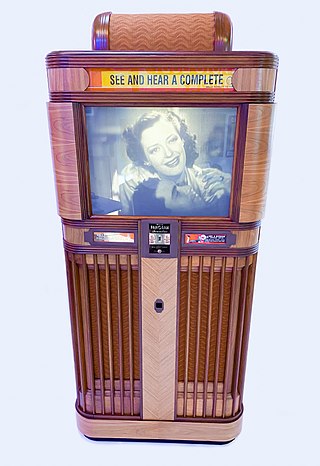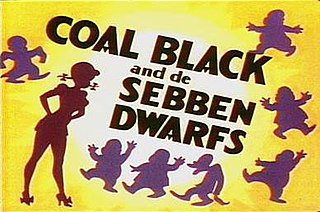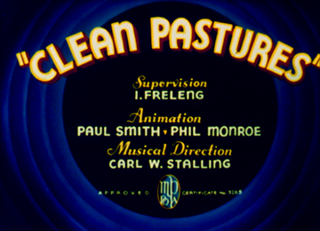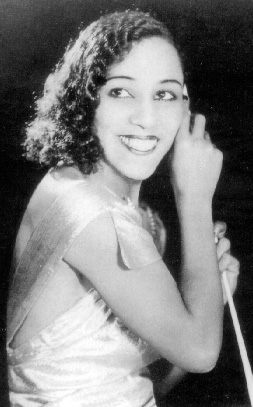Related Research Articles

Cabell Calloway III was an American jazz singer and bandleader. He was a regular performer at the Cotton Club in Harlem, where he became a popular vocalist of the swing era. His niche of mixing jazz and vaudeville won him acclaim during a career that spanned over 65 years.

A soundie is a three-minute American musical film displaying a performance. Soundies were produced between 1940 and 1946 and have been referred to as "precursors to music videos". Soundies exhibited a variety of musical genres in an effort to draw a broad audience. The shorts were originally viewed in public places on "Panorams": coin-operated, 16mm rear projection machines. Panorams were typically located in businesses like nightclubs, bars, and restaurants. Due to World War II, Soundies also featured patriotic messages and advertisements for war bonds. More adult shorts, such as burlesque and stripteases, were produced to appeal to soldiers on leave.

Bosko is an animated cartoon character created by animators Hugh Harman and Rudolf Ising. Bosko was the first recurring character in Leon Schlesinger's cartoon series and was the star of thirty-nine Looney Tunes shorts released by Warner Bros. He was voiced by Carman Maxwell, Johnny Murray, and Billie "Buckwheat" Thomas during the 1920s and 1930s and once by Don Messick during the 1990s.

Coal Black and de Sebben Dwarfs is a 1943 Merrie Melodies animated cartoon directed by Bob Clampett. The short was released on January 16, 1943.

The Cotton Club was a New York City nightclub from 1923 to 1940. It was located on 142nd Street and Lenox Avenue (1923–1936), then briefly in the midtown Theater District (1936–1940). The club operated during the United States' era of Prohibition and Jim Crow era racial segregation. Black people initially could not patronize the Cotton Club, but the venue featured many of the most popular black entertainers of the era, including musicians Fletcher Henderson, Duke Ellington, Jimmie Lunceford, Chick Webb, Louis Armstrong, Count Basie, Fats Waller, Willie Bryant; vocalists Adelaide Hall, Ethel Waters, Cab Calloway, Bessie Smith, Lillie Delk Christian, Aida Ward, Avon Long, the Dandridge Sisters, the Will Vodery choir, The Mills Brothers, Nina Mae McKinney, Billie Holiday, Midge Williams, Lena Horne, and dancers such as Katherine Dunham, Bill Robinson, The Nicholas Brothers, Charles 'Honi' Coles, Leonard Reed, Stepin Fetchit, the Berry Brothers, The Four Step Brothers, Jeni Le Gon and Earl Snakehips Tucker.
"Minnie the Moocher" is a jazz-scat song co-written by American musician Cab Calloway and first recorded in 1931 by Calloway and his orchestra, selling over a million copies. "Minnie the Moocher" is most famous for its nonsensical ad libbed ("scat") lyrics. In performances, Calloway would have the audience and the band members participate by repeating each scat phrase in a form of call and response, eventually making it too fast and complicated for the audience to replicate.
Theatre Owners Booking Association, or T.O.B.A., was the vaudeville circuit for African American performers in the 1920s. The theaters mostly had white owners, though about a third of them had Black owners, including the recently restored Morton Theater in Athens, Georgia, originally operated by "Pinky" Monroe Morton, and Douglass Theatre in Macon, Georgia owned and operated by Charles Henry Douglass. Theater owners booked jazz and blues musicians and singers, comedians, and other performers, including the classically trained, such as operatic soprano Sissieretta Jones, known as "The Black Patti", for black audiences.

Irving Harold Mills was an American music publisher, musician, lyricist, and jazz promoter. He often used the pseudonyms Goody Goodwin and Joe Primrose.

Clean Pastures is a 1937 Warner Bros. Merrie Melodies cartoon directed by Friz Freleng. The short was released on May 22, 1937.

Stormy Weather is a 1943 American musical film produced and released by 20th Century Fox, adapted by Frederick J. Jackson, Ted Koehler and H.S. Kraft from the story by Jerry Horwin and Seymour B. Robinson, directed by Andrew L. Stone, produced by William LeBaron and starring Lena Horne, Bill "Bojangles" Robinson, and Cab Calloway. The film is one of two Hollywood musicals with an African American cast released in 1943, both starring Lena Horne, the other being MGM's Cabin in the Sky. Stormy Weather is a primary showcase of some of the leading African American performers of the day, during an era when African American actors and singers rarely appeared in lead roles in mainstream Hollywood productions. The supporting cast features the Nicholas Brothers in arguably the screen's most bravura dance sequence, Fats Waller, Katherine Dunham and her dancers, and Dooley Wilson. Stormy Weather takes its title from the 1933 song of the same title, which is performed almost an hour into the film. It is loosely based upon the life and times of its star, dancer Bill "Bojangles" Robinson.

Blanche Dorothea Jones Calloway was an American jazz singer, composer, and bandleader. She was the older sister of Cab Calloway and was a successful singer before her brother. With a music career that spanned over fifty years, Calloway was the first woman to lead an all-male orchestra and performed alongside musicians such as Cozy Cole, Chick Webb, and her brother. Her performing style was described as flamboyant and a major influence on her brother's performance style.

The Metro-Goldwyn-Mayer cartoon studio was an American animation studio operated by Metro-Goldwyn-Mayer (MGM) during the Golden Age of American animation. Active from 1937 until 1957, the studio was responsible for producing animated shorts to accompany MGM feature films in Loew's Theaters, which included popular cartoon characters Tom, Jerry, Droopy, Butch, Spike, Tyke, and Barney Bear.

That's Black Entertainment is a 1989 documentary film starring African-American performers and featuring clips from black films from 1929–1957, narrated and directed by William Greaves. The clips are from the Black Cinema Collection of the Southwest Film/Video Archives at Southern Methodist University in Dallas, Texas. It is 60 minutes long and was distributed by Video Communications of Tulsa, Oklahoma.

Hi De Ho is a 1947 American musical race film directed by Josh Binney. Distributed by All American Entertainment, the film stars an all African American cast, led by Cab Calloway. It first showed at the Squire Theatre in New York, and would be shown in the more than 500 African-American theaters in the US.

Mother Goose Goes Hollywood is a 1938 animated short film produced by Walt Disney Productions and distributed by RKO Radio Pictures. The short was released on December 23, 1938. The film parodies several Mother Goose nursery rhymes using caricatures of popular Hollywood film stars of the 1930s. The film was directed by Wilfred Jackson and was the third-to-last Silly Symphony produced.
Jive talk, also known as Harlem jive or simply Jive, the argot of jazz, jazz jargon, vernacular of the jazz world, slang of jazz, and parlance of hip is an African-American Vernacular English slang or vocabulary that developed in Harlem, where "jive" (jazz) was played and was adopted more widely in African-American society, peaking in the 1940s.
The Old Mill Pond is a 1936 American animated short film in the Happy Harmonies series, directed by Hugh Harman for the Metro-Goldwyn-Mayer cartoon studio.

Minnie the Moocher is a 1932 Betty Boop cartoon produced by Fleischer Studios and released by Paramount Pictures.
The Cotton Club Boys were African American chorus line entertainers who, from 1934, performed class act dance routines in musical revues produced by the Cotton Club until 1940, when the club closed, then as part of Cab Calloway's revue on tour through 1942.

Black Performance of Jewish Music has a long, studied, history of Black and Jewish musicians, songwriters, and performers influencing each other through their unique cultures that helped provide both groups with inspiration. Along with this collaboration, there is also the element of Jewish songs having a direct impact on Black musicians. Throughout musical history there are many iconic moments where Black artists performed Jewish music, including notable figures such as Paul Robeson, Cab Calloway, and Aretha Franklin. Many of these Black artists claim to feel a connection to the Jewish songs and people from their shared desire for freedom and sadness from leaving their ancestral lands.
References
- ↑ Lenburg, Jeff (1999). The Encyclopedia of Animated Cartoons. Checkmark Books. p. 89. ISBN 0-8160-3831-7 . Retrieved June 6, 2020.
- ↑ quoted in Ian Conrich, et al. Film's Musical Moments. Edinburgh University Press, 2006. 23.
- ↑ Ian Conrich, et al. Film's Musical Moments. Edinburgh University Press, 2006. 23.
- ↑ Jesse Hamlin. "Jazz in the City Benefit". San Francisco Chronicle . August 21, 1988.
- ↑ "The Jazz Frogs". Wild Realm Reviews.
- 1 2 3 Sampson, Henry T. (1998). That's Enough, Folks: Black Images in Animated Cartoons, 1900-1960. Scarecrow Press. p. 212. ISBN 978-0810832503.